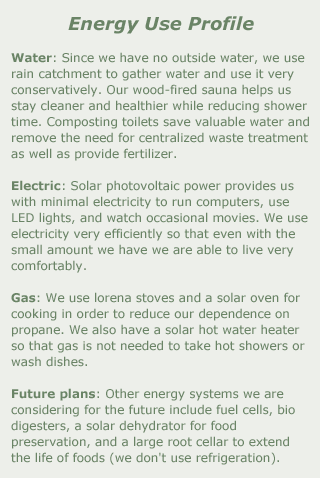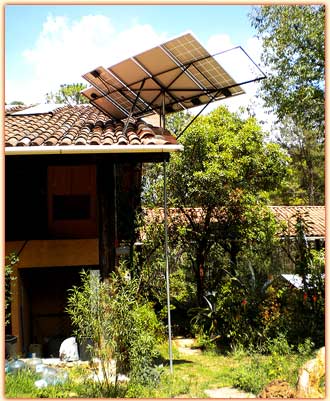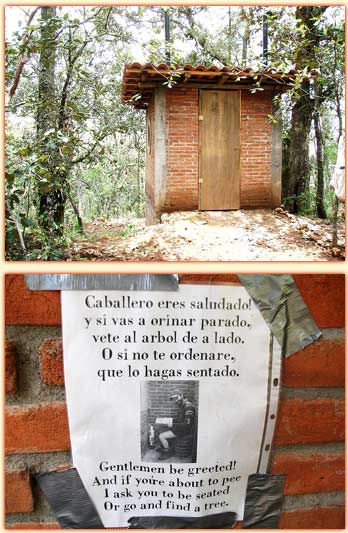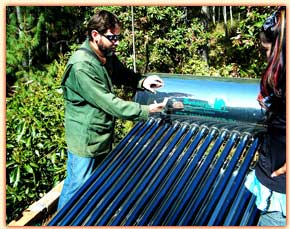![]()

Solar Power
Sustainable Cooking
Rain Collection
Composting Toilets
Solar Hot Water Heater
At the Bosque, in order to achieve sustainability we draw upon the wisdom from every age from pre-human to visions of post-human and from every culture around the world. We want to use the best of human thought combined with the wisdom inherent in the evolution of life and its complex systems.
We do our best to keep our ecological footprint very low, but we do recognize there will always be room for improvements. It will be interesting to watch as technology continues to grow and provide us with new tools and ideas. Hopefully the road to a sustainable lifestyle will become increasingly accessible to all.
Solar Power
Rather than rely on city electricity, we have installed solar panels so that we can use the energy from the sun to provide us with power.
The Photovoltaic Solar Power System
- We have eight golf cart batteries, a Xantrex charger/inverter, and four Kyocera 130 watt photovoltaic panels.
- We decided to have a centralized solar power system which runs electricity to five buildings, the furthest of which is 200 meters away from the panels. By using modern efficient inverters we convert 12V power to 120V and are able to efficiently send electricity over long distances and avoid the need to buy specialized 12V devices.
- Simple maintenance of the batteries twice a year is required.
 Conserving energy
Conserving energy
The primary dollar cost savings are from our conservation of electricity rather than the fact that our electricity comes from solar power. If we did rely on city power, our electric bill would be very small. We use an estimated 5% of the electrical power that a normal household uses.
We have enough power to use laptops, watch occasional movies, and use compact florescents and LED lighting. We are conscious of every device we plug in. Hair dryers, coffee makers, and irons use too much power for our system to support. Charging cell phone or camera batteries is done during the day, when there is plenty of sunlight. Every afternoon we check to make sure we haven’t left anything plugged in that is not being used. We must work together and remind each other to not waste electricity. Several ghost loads (devices left plugged in, using a small amount of power) can become a large enough drain on our system that it will not be able to provide us with luxuries such as the internet or an evening movie. Improvements in LED lights continue to give us more light per watt.
Other sources of electrical energy
We are always watching the latest developments for new sources of electricity. Wind power does not appear to make sense here. Fuel cells combined with solar electric production of hydrogen may provide for our energy needs in the future.
Sustainable Cooking
Everybody has to eat! Since we love cooking and we love sustainability, we have delved into the art of sustainable cooking. Tindu kitchen, our main kitchen, still relies on propane for meals, but more and more we are turning off the gas and lighting an efficient fire or using the power of the sun to cook our food.
Solar Ovens
There are few things we like more than free energy and consistency. Solar cooking has both of these traits during the dry season, when there is rarely a cloud in the sky. We use the sun’s energy to heat our solar oven up to 138 degrees C (280F).
Our solar oven consists of a reflective dish in which we can place a pot which functions as the oven. Perfect for beans, rice, soups, breads and cakes.
We have plans to make sturdier, more inexpensive models with some design changes. Our next model will also take into account our location, as the angle of our current oven is more appropriate for higher latitudes.
We fed some cake to a couple of our friends who live in a nearby village and they were astounded at the prospect of cooking without fuel. Propane gas use is a major cost of cooking, so solar ovens could reduce cooking costs significantly. We hope to be able to offer inexpensive, easy to construct plans in Spanish to help our friends introduce solar cooking to their families and friends.
Wood-fired cooking
For times when solar cooking is not an option such as in the rainy season when it can be cloudy, wood-fired options reduce our reliance on gas and still allow us to heat up tea and foods.
Designed properly, stoves can use wood efficiently and sustainably. We have built three lorena stoves which are fired with pine, and are planning for a wood-fired oven to bake bread. Our lorena stoves are constructed out of brick and have a very small firebox which channels the smoke towards metal burners and then up and out a chimney, away from the kitchen.
Lorena stoves reduce one of the biggest problems worldwide for women, which is smoke inhalation while cooking in the kitchen. Our stoves are designed so that the smoke exits the area, and they are located outdoors with plenty of ventilation. Our two outdoor kitchens take advantage of the pleasant climate and make stoves available for people outside of the primary food production kitchens.
Future Plans
We will build an insulated cooker, or hay box, that will allow us to continue cooking food that has been heated up, and free up the solar oven for the next food.

Rain Collection
Water is an essential resource here at the Bosque. The best way to live without relying on city water is to catch and store the rain.
 The rainy season in Michoacán lasts from June to September. The average annual rainfall is 77 cm (30 inches). But during the dry season from November through May, we find ourselves in near-drought conditions. Because we only get rain for four months out of the year, it is critical to our survival that we have high quality storage systems in place to keep water for showers, cooking, and occasional irrigation for the remaining eight months of the year.
The rainy season in Michoacán lasts from June to September. The average annual rainfall is 77 cm (30 inches). But during the dry season from November through May, we find ourselves in near-drought conditions. Because we only get rain for four months out of the year, it is critical to our survival that we have high quality storage systems in place to keep water for showers, cooking, and occasional irrigation for the remaining eight months of the year.
The Black Rock Lodge cistern was completed in May 2006. It is the largest cistern on the property, holding 68,000 liters of water. Combined with two other cisterns and various small tanks, we collect and store over 100,000 liters of water every rainy season. So far, this has been enough to sustain our small community. In the upcoming years we will build more cisterns to accommodate our growing numbers.
Rain Water Uses
We use rain water for showers, cooking, cleaning, and occasionally for irrigation. We don’t currently treat our rain water, so we do not use it as drinking water for our visitors. Unfortunately, this means that we do rely on buying drinking water from town. One of our goals is to set up a UV treatment system for our water so we can guarantee that the water from the cisterns is suitable for drinking. Until then, visitors drink bottled water that is available in all our buildings.
By using composting toilets we do not mix perfectly useful water with human waste.
We estimate that our water use is at about 35% of a usual household’s.
Cistern Construction
There are many different methods for constructing water storage systems, each with advantages and disadvantages. Plastic, fiberglass, metal, concrete, and ferro-cement are all materials that are used to hold rain water. So far our cisterns have been built using stone and cement. While concrete is a high energy embodied material, our concrete cisterns should last indefinitely.
Cistern size depends on the square footage of the roof the water will be collected off of and the annual average rainfall:
Max annual gallons to capture = Annual rainfall in inches * roof square footage * .623 gallons
We build cisterns so that we can use the top for decks and patios. The largest cistern sits off the front of the Lodge and is a wonderful spot to enjoy the view of the forest and watch the birds at the birdbath. During the dry season we move a fire pit to the deck to enjoy the stars in the open air.
 Composting Toilets
Composting Toilets
We have six composting toilets. Composting toilets convert human waste into compost – usable soil. Wikipedia has a great article on the history of composting toilets and how they work. For our composting toilets, each toilet has two chambers. One is used for a year, then we switch to using the other side. The side which is not in use has intense microbial activity with the temperature raising to 77 C (170 F) as the material composts. Late in the composting cycle worms can be added for a cycle of vermicomposting. After a year, that side is ready to be emptied of its soil, which can be used on gardens. We use the compost on non-food gardens, but scientific data suggests the soil is perfectly safe for food gardens as well.
Before it’s annual use cycle, the chamber is prepared with carbon-high grasses which grow natively in the forest. After every use a handful of oak leaves or sawdust is tossed into the toilet to balance the carbon and nitrogen and aid in the composting activity and in eliminating odors. Ventilation tubes also eliminate odors.
The major advantage of composting toilets is that useful water is not combined with human waste, which then needs to be sent to a centralized sewage treatment plant to be processed. Approximately 40% of normal household water is used just for flushing toilet. We use none.
Our composting toilet design is combined from two books as well as designs found online:
The Humanure Handbook: A Guide to Composting Human Manure, Third Edition
Composting Toilet System Book: A Practical Guide to Choosing, Planning and Maintaining Composting Toilet Systems
Our design is very simple because we have both space and time. For us, it is not necessary to have expensive composting toilets with fans and electricity.
Using collected old style water toilets we are building an art sculpture: The Shrine to the Outmoded Commode.
Solar Hot Water Heater
 At an elevation of over 2,400 meters (7,800 ft) and clear skies for most of the year, solar hot water heating makes great sense. While photovoltaic solar electric power may not make sense for all households, solar hot water heating is a sure win and reduces reliance on propane gas or electric hot water heating.
At an elevation of over 2,400 meters (7,800 ft) and clear skies for most of the year, solar hot water heating makes great sense. While photovoltaic solar electric power may not make sense for all households, solar hot water heating is a sure win and reduces reliance on propane gas or electric hot water heating.
The principal is simple. Cold water enters into an insulated tank, then flows into black tubes which are heated by the intense power of the sun. The tubes are sheathed in an outer glass tube which contains a vacuum. Since the heat of the black tubes cannot pass across a vacuum, it is all trapped with the water. The heated water rises to the insulated tank and is available for use. Like a big thermos, the tank keeps water hot all through the night.